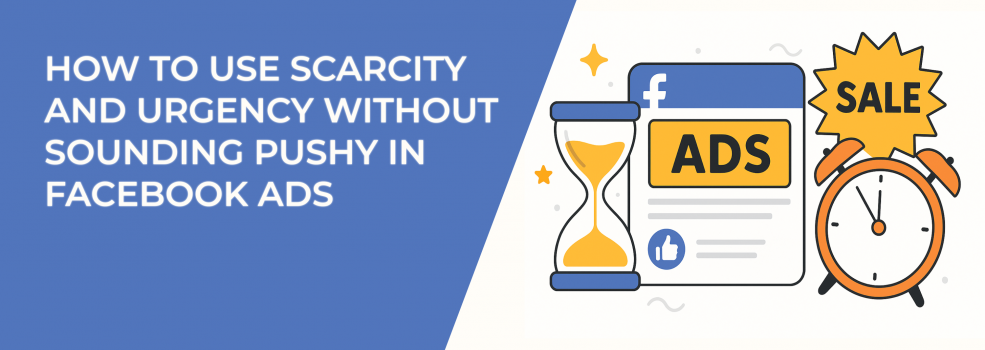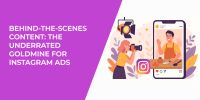Scarcity and urgency are powerful in Facebook ads — but only when used with care. Overdoing them can make your brand sound desperate or fake. And today’s audiences are quick to scroll past anything that feels too aggressive.
So how do you get people to take action without sounding pushy? It starts with being real, clear, and respectful of your audience’s time.
Let’s look at how you can use scarcity and urgency in your ads in a way that builds trust and still gets results.
Why Scarcity and Urgency Work
People pay attention when they think they might miss out. That’s why limited offers often perform better than open-ended ones. But if your message feels forced or exaggerated, it can have the opposite effect.
The best kind of urgency is based on real limits, not made-up deadlines.
Use scarcity when:
-
You have limited stock, such as handmade products or small batches.
-
You have a real deadline, like a class or event with a specific start date.
-
You have limited capacity, such as one-on-one services or coaching spots.
When these limits are true, people are more likely to trust your message and act on it.
Be Honest About Why There’s a Limit
“Only 5 left!” isn’t enough. People see messages like that all the time — and often don’t believe them. If there’s a real reason, say it.
Examples:
-
“We only take 10 clients per month to keep our service high-quality.”
-
“Our next production run is in mid-August — orders close Sunday.”
-
“This offer ends Friday so we can onboard new clients next week.”
When there’s a clear reason behind the limit, it feels more real. It also makes your brand feel more trustworthy.
Other ways to frame it:
-
“We cap class sizes so everyone gets personal support.”
-
“This batch is small — we make everything in-house.”
-
“Orders close Friday to meet our shipping schedule.”
Limits don’t have to be dramatic. Just make them make sense. Clear, honest messages build trust — and that leads to better results.
Set Clear Deadlines
Deadlines work. They encourage people to act. But they don’t have to be loud or dramatic to be effective.
Skip vague or high-pressure lines like:
-
“Hurry! Offer ends soon!”
-
“Don’t miss out — time is running out!”
These feel rushed — and they don’t give people anything to plan around.
Instead, be clear and specific:
-
“Join by July 14 to be part of the next group.”
-
“This rate is available until midnight on Friday.”
-
“Enrollment closes Sunday so we can start working with new clients Monday.”
These messages feel calm, but still focused. They tell people what to do and when to do it.
Other examples:
-
“Book your spot by Thursday to lock in the early rate.”
-
“Next round starts August 1 — registration ends a week before.”
A good deadline creates momentum, not pressure. It helps people decide and take the next step without feeling rushed.
Tip: align your deadlines with something practical. A shipping date, a program start, or a team schedule. When there’s a reason behind the timing, it’s easier for people to trust and act on.
Short-term campaigns naturally support time-based urgency. Learn how to drive results with short-term Facebook campaigns that convert.
Keep the Tone Friendly
Urgency doesn’t have to sound like an alarm. If your ad feels too intense, people tune it out — or worse, get annoyed.
Avoid lines that feel like warnings:
-
“Act now before it’s too late!”
-
“Only 1 left — don’t miss this!”
-
“Time is running out!”
These create pressure, not trust. They can also feel fake, especially if users have seen similar ads before.
Instead, use a tone that’s calm, helpful, and clear:
-
“We’re opening a few early spots this week.”
-
“This is our only July release — we’ll restock in September.”
-
“Booking closes soon so we can focus fully on our new clients.”
These still create urgency but they feel thoughtful, not pushy. Keep the language human. Imagine explaining the offer to a friend — what would you actually say?
Tip: read your ad out loud. If it sounds like a sales pitch, soften it. If it sounds like something you'd naturally say in conversation, you’re on the right track.
Use Visuals That Support Your Message
You don’t need flashy graphics to make your ad feel urgent. In fact, over-the-top visuals can hurt your credibility — especially on Facebook and Instagram, where users scroll quickly and avoid anything that looks like a hard sell.
The best visuals are simple, clear, and on-brand. They support the message without shouting. Try subtle elements like:
-
A progress bar that shows “80% full” or “5 spots left.”
-
A calendar graphic highlighting available dates or a closing window.
-
A clean badge with text like “Final Week,” “Limited Time,” or “Ends Friday.”
These visuals reinforce scarcity without creating stress.
Other useful ideas:
-
A countdown banner — small and tucked into a corner, not front and center.
-
A soft overlay that says “Last Call” on top of your product photo.
-
A timeline graphic showing key dates — open, close, and fulfillment.
Tip: stick to your brand’s color palette. Avoid bright red, flashing effects, or pop-up-style warnings. These can make your ad look spammy and reduce trust.
Also, make sure the visual matches the message. If your ad talks about a small release or limited stock, show that with your layout. A clean, minimal design with a focused headline often outperforms something loud and busy. Here’s how to design standout Facebook ad creatives that stay true to your brand.
Talk About What Happens After the Deadline
Deadlines work better when people understand why they exist — and what happens after they pass. Urgency feels more real when there’s a clear next step or a pause in availability.
Instead of just saying something ends, show what changes.
Examples:
-
“After this week, we shift focus to current clients and won’t reopen bookings until August.”
-
“These products take time to make, so we won’t have another batch ready for a few weeks.”
-
“We’re closing the cart on Friday to get everything shipped on time.”
These give the deadline a reason. There’s a clear outcome and it makes sense.
Other strong messages:
-
“After Sunday, our team is fully booked through next month.”
-
“Once the doors close, we’ll begin onboarding — no late entries.”
-
“We’ll reopen the waitlist after the current round wraps up.”
This kind of messaging helps people plan — and makes them more confident about taking action.
Tip: be specific. Mention dates, schedules, or steps in your process. When people know what happens next, the offer feels more structured and professional.
Use Facebook Tools to Test What Works
Not every audience responds the same way. Use Facebook’s ad tools to test different versions of your message.
Try testing:
-
Two tones — one casual, one direct.
-
Two formats — one with urgency, one without.
-
Two visuals — one with a timer or badge, one without.
Watch for key signs of success like higher click-through rates, more conversions, and better engagement. If an ad gets a lot of negative feedback or people hide it, the message might be too strong.
Data will help you adjust without guessing.
If you're not sure whether to start testing creative, copy, or audience first, this guide breaks it down: what to test first in your Facebook campaigns.
Final Thoughts
Urgency doesn’t need to be loud. Scarcity doesn’t have to feel forced. When you share real limits with simple, honest language, your ads feel helpful — not pushy.
Focus on:
-
Clear deadlines,
-
Real reasons,
-
Friendly tone,
-
And simple design.
People will respond when they believe the opportunity is real — and worth acting on today.

